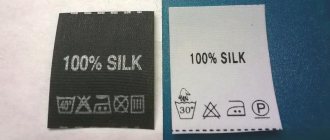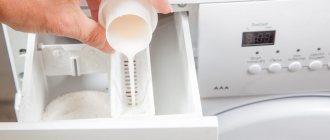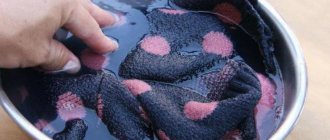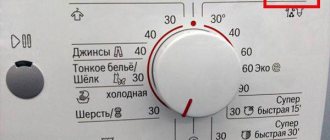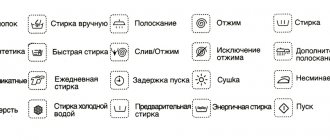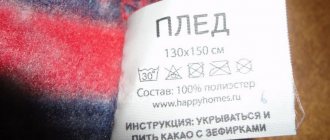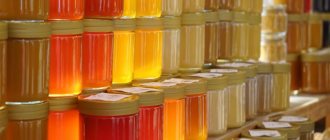Home / Articles / At what temperature to iron cotton, wool, silk and other fabrics
22 Feb 2018
Category: Articles
No comments
In order for clothes to retain their original appearance for a long time, they must not only be properly washed and dried, but also ironed. In ancient times, housewives smoothed things out using a stone or roller heated in a flame, and there was practically no risk of ruining the fabric. Then irons appeared, heated with coal, which took root in everyday life for a long time. And only many years later the first electric iron was invented - a very convenient device that requires great care and precision in handling.
Read in this article:
- What you need to know about ironing temperature
- Icons on labels - what do they mean?
- Wool ironing temperature
- Ironing silk items
- Ironing linen and cotton
- Tips for ironing synthetics
- What items cannot be ironed?
How to iron things depending on the composition of the fabrics
Depending on their composition, different types of fabrics require different ironing modes:
If cotton and linen can be ironed at maximum temperatures using large amounts of steam, then you need to be very careful with chiffon. Steam and spray mist can stain delicate fabrics. Natural silk is very capricious. Silk products are not moistened, but ironed in an undried state from the inside out through gauze. The same goes for wool. If possible, products made from it are not ironed, but hung on hangers over steam.
Satin is ironed with extreme care when wet. The iron is not held in one place for more than 2 seconds
Use an iron and iron in the “silk” mode. Viscose is a capricious fabric. It should be ironed as quickly as possible and through gauze, since it tends to lose color and texture if the iron is held in one place for more than a few seconds. Products made from velor, as a rule, are not ironed, since velor does not wrinkle. If, however, folds have formed, the product is steamed without touching the iron, or suspended above the steam. Faux fur - ironed from the front side through damp gauze in the direction of the pile. Suede products should not be ironed. Use either a steamer or keep it over steam until the wrinkles disappear completely. The lace is ironed from the inside out through an ironing iron on a soft backing.
Video: look at the fabric, then iron it
The main parameters for ironing various types of fabrics are shown in the table below.
Table: recommended parameters for wet-heat treatment of various materials
Material Steam quantity Steam quality Temperature, °C Instructions Cotton Medium Wet 180–220 Need pressure Cotton velor Average Less damp 180–220 Avoid pressure Linen Much Wet 215–230 Cotton + linen Much Wet 180–220 Wool Much Wet 160–170 Silk Very little Less wet 140–165 Without water Viscose Medium Wet 150–180 Acetate Little Dry 180–190 Be careful, las! Fine Jersey Few Dry 140–150 Beware, lassies! Wool Jersey Light Dry 140–150 Polyester (Polyester) Very Light Very Dry 160–200 Polyamide Light Dry 150–160 Polyurethane (Elastane) Very Light Dry 150–180 Polyacrylonitrile (PAN) Very Light Dry 150–180 Raincoat Light Very Very Dry 180 –220 Cotton + synthetics Average Dry 160–170 Wool + PAN Average Little moisture 160–180 Cotton corduroy Average Less wet 180–190 Rib movement Knitwear Average Wet 150–180 Without distortion
Everyone can easily cope with routine ironing. You just need to take into account a few simple rules, then the process will go faster and with pleasure.
Decoding the signs on the labels
Each item of clothing contains a special label, which indicates the features of caring for the item. They indicate recommendations for washing, drying and ironing. The most important thing is to be able to decipher them.
Figure 1. Designations of ironing modes.
- Iron. Allows you to iron the product without any special features.
- Iron with 3 points inside. Ironing is allowed at high temperatures up to 200°C. Applicable for linen and cotton.
- Iron inside a circle. Maximum temperature 140 °C. Polyester, polyacrylonitrile fabrics.
- Iron with 2 points. Temperatures up to 150°C. Used for viscose, wool, polyester, polyester, silk.
- Iron with 1 point. Provides ironing at a temperature not exceeding 110°C. Acetate, polyamide, nylon, viscose, nylon.
- The iron is crossed out. Ironing and steaming are prohibited.
- Iron with 1 dot, steam crossed out at the bottom. You can't steam it.
Failure to follow the recommendations on clothing labels can lead to irreversible damage to items.
Without steamer
If you don’t have a steamer or iron at home, or, for example, there’s a power outage, you can straighten the curtains using steam. You need to get steam by simply boiling water. For this method you will need a kettle (gas or electric) or a small saucepan filled with water. Bring the water to a boil and continue boiling for another 5 minutes. Then take a container of boiling water and bring it to the hanging curtain. Direct the steam so that it hits the fabric. Use your hands to straighten the fabric and remove creases. The material smooths out before our eyes and has a neat appearance. For better results, you can slightly wet the curtains with a clean damp cloth; they will smooth out much better and faster.
How to iron linen and home textiles
It is better to iron bamboo, linen and cotton items a little damp. When there are decorative inserts, use gauze. Here are some useful tips:
- The sheets have elastic. The linen is folded in half, then in half again, then ironed. It is necessary to ensure that there are no folds or creases on the product. You can iron in another way: start from the center, gradually turning the fabric itself, moving in a circle. But it’s easiest to iron it directly stretched on the mattress.
- Duvet covers. First, all buttons and zippers are fastened, the product is straightened and ironed on one side. Then fold it in half so that the wrinkled side remains on the outside and iron it. And so on until the duvet cover takes the desired size for storage.
- Silk bedding. Many people do not know how to iron silk bed linen: they iron it half-dry, only from the inside out.
- Tablecloths. If they are trimmed, ironing starts from the edge and ends in the middle. It is better to fold a regular tablecloth 4 times and iron it one by one on all sides.
- Curtains. The easiest way to iron them is by vertical steaming using a steam generator. If there is none, chairs are placed around the ironing board to lay the ironed fabric. Iron the curtain from above, moving downwards.
Basic ironing modes
Even novice housewives know that the iron can be used in several modes. But not everyone understands the intricacies of the differences between different ironing methods. But the result largely depends on the right choice!
There are three main modes of using the iron:
- The dry regime is the most ancient. It was used in the very first irons, in which heating was carried out by the heat of coals embedded in the body. The smoothing effect in this mode is provided by the weight of the iron, the sliding of its sole and the surface temperature. The main disadvantage of the regime is the high risk of damage to things. If you hold the iron in one place, a charred spot will appear.
- Ironing dampened fabric. In this case, the product to be smoothed is wetted using a spray bottle or wet gauze. Moisture makes fabric fibers softer, reduces friction and makes ironing easier. The disadvantage of this method is the need to manipulate additional devices. It takes experience to learn how to properly moisturize your clothes.
- Steaming mode. In it, the iron creates a stream of steam, which is directed through special holes on the sole onto the item. Steam allows you to effectively and quickly deal with wrinkles on fabric. However, the built-in steamer complicated the design of the iron, which means it increased the price of the device and made it more difficult to operate and care for.
The preference for one mode or another should not negatively affect the service life of the iron
But it is important to understand in what cases each ironing method is used, otherwise more labor will be required. The risk of clothing damage if ironing is done incorrectly also increases.
How to iron synthetics, plush, corduroy?
The popularity of viscose is due to its bright colors, ease of care, pleasant appearance and inexpensive cost. But, first of all, you should remember that viscose is a synthetic material that requires careful handling. Iron it at a temperature of no more than 110 degrees. The fabric must not be sprayed or treated with steam.
Products made of velvet and plush are ironed from the inside out and through a cloth without pressing the iron. If you need to straighten the folds, it is better to steam it by holding it over boiling water in a saucepan.
The vertical position of the iron when ironing a corduroy item hanging on a hanger will preserve the properties of the pile.
Important Features
To make your work easier, you need to take into account the characteristics of the material:
- Cotton fabric must be ironed on both sides, otherwise it will still look untidy.
- It is advisable not to leave silk bedding until completely dry, but to begin ironing it while still damp. Iron only on the reverse side, do not splash water on it.
- It is harmful to use additional moisture when processing satin linen. It must be laid out on the ironing board with the wrong side up and the “dry” method used to avoid water stains.
- It is better to go over the chintz with an iron from the front side, not forgetting to wet the surface with a spray bottle.
- To quickly iron synthetic fabric, use gauze or a thin, clean cloth. The main product must first be completely dried.
- Dark colored material must be ironed correctly from the wrong side, otherwise there is a high risk of shiny marks appearing on the fabric.
- If there are decorative elements on the linen in the form of applique or embroidery, you can treat them with a steamer. Iron only from the inside out, placing the decor on a soft terry towel.
Features of heating irons
Every housewife knows that a good iron should have the following qualities:
- uniform heating of the sole;
- moderate weight;
- smooth glide.
It is very important that the set temperature for ironing fabrics on the device is maintained evenly over the entire surface of the sole. This indicator largely depends on the material of manufacture. For these purposes the following are used:
- ceramics;
- aluminum;
- steel;
- cast iron.
Ceramics have proven themselves best. The temperature maximum occurs in the center of the sole, gradually decreasing towards the edge. The approximate difference between the center and the outskirts is about 10 °C.
Most devices have in their design such components as a heating element, thermostat, signal lamp and steam function.
Each iron operating mode has 3 temperature values: nominal, maximum and minimum. The data is presented in the table.
Table 1. Iron sole temperature values for different modes
| • | •• | ••• | |
| Maximum value, °С | 115 | 155 | 205 |
| Minimum, °С | 75 | 105 | 145 |
| Nominal, °С | 95 | 130 | 175 |
Ironing complexly shaped clothes
Most of the methods described above are suitable for straightening simple items of clothing, such as a T-shirt. It is much harder to tidy up a shirt or pleated skirt.
The following ironing methods are most suitable for such products:
- Its complete absence. Things are completely wetted and carefully secured on hangers, tucks and other devices to avoid creases and bends. In this position, the shirt or blouse is left until completely dry.
- Ironing with a hot lamp. This method is suitable for extreme situations when it is urgent to get rid of wrinkles. Take a light bulb and carefully wipe it from dust and dirt, then screw it into the lamp. It is advisable to first remove the lampshade from it. Plug it in and wait for the light bulb to warm up well. Apply this “iron” over the surface of the product and remove all irregularities.
The use of the last available means is associated with some danger to humans. It is necessary to ensure that the lamp does not overheat too much, as bright scorch marks will appear on the product. Clothes must be completely dry and the lamp must be in good condition.
How to iron properly without water?
First of all, you need to thoroughly drain the water from the tank. It is recommended to do this every time you put the iron away for storage. But before you start dry ironing, it doesn’t hurt to check again if there is any water in the steamer container. If the last few drops cannot be drained in any way, take an unnecessary piece of cloth and iron it in the steam mode until all the water has evaporated.
Before dry ironing, the steam supply is completely closed with the regulator. The item is ironed with quick movements. Usually you have to iron each item on both sides. The ironed item should be left to hang for 30–60 minutes.
We hope that our tips will help you learn how to iron without water correctly. And then your clothes will look perfect. It's worth the effort, isn't it?
Temperature conditions for ironing main types of fabrics
Linen
Linen clothing has excellent breathable and thermal conductivity properties. With proper care, it retains its qualities for a long time. To ensure that linen items do not lose their original appearance, they require special care.
How to iron linen correctly:
- The iron temperature when ironing should be 180–200 °C (3 points).
- Turn inside out.
- Provide moisture to clothing. It is better to treat almost immediately after washing or use a spray bottle.
- Intense pressure on the iron.
- Allows you to turn on the steam function.
High-quality ironing of natural linen requires high temperature and humidity. We must not forget that this fabric wrinkles easily, so achieving an ideal result will be quite difficult.
If the material contains additions of other fibers, for example, cotton, then the temperature should not be set above 180 °C.
Particular attention should be paid to the presence of decorative elements. Embroideries and patterns are ironed exclusively from the inside and only through gauze
Direct contact with the base of the device is not allowed.
Very thick clothes are ironed on both sides, but using gauze. For starched items, the temperature should be reduced by about 10–20 °C from the maximum.
Cotton
Clothing made from this material is the most popular. Cotton is a fairly dense fabric that perfectly absorbs moisture and allows air to pass through well. It is used to make bed linen, dresses, shirts and many other things. To properly iron your products, you should follow these recommendations:
- Ironing temperature for cotton is 170–180°C.
- Do not dry completely. Treat wet or using a spray bottle.
- Press firmly on the iron.
- Using wet steam.
In its pure form, cotton is quite difficult to iron. The process requires high temperature and strong pressure. If the item contains the addition of polyester, the heating of the sole must be reduced to 110 °C.
Products without patterns or embroidery are processed from the outside; if there are decorative elements or paints, the clothes must be turned inside out. To obtain maximum effect, you must follow the recommendations indicated on the clothing label.
Silk
Silk is a delicate material that requires careful handling. It dries quickly and has a delicate texture. The fabric is very sensitive to external influences, so you need to know the main rules on how to iron silk.
Rules:
- Silk ironing temperature 60–80 °C (one dot or corresponding inscription on the device panel).
- The use of steam is prohibited. Difficult to remove stains may remain.
- Use a thin cloth, but not gauze. She also leaves streaks on the silk. In this case, a temperature increase of 10–20 is permissible.
- The direction of movement is vertical. Otherwise, the fabric may stretch.
How to iron a silk dress or shirt with a complex cut:
- Hang the product on hangers.
- Cover the top with a thin, slightly damp cloth.
- Heat the device to the temperature indicated on the label. If it is not possible to view the information, then set the mode to 1 point or 1 point on the iron.
- Slowly move the steam at a distance of 4–7 cm from the dress using vertical movements.
The same rules should be followed when working with chiffon and polyester.
Wool
Soft, natural material that is resistant to high temperatures. For safe ironing, you should adhere to the following rules:
- Temperature for ironing wool is 100–120 °C.
- Turn inside out.
- It is better to replace continuous moving of the iron by moving it from place to place. This method will avoid deformation of the fabric.
- Use additional moisture in the form of cotton fabric.
Woolen items are very finicky and do not always tolerate ironing. Read label recommendations carefully. It is better to give preference to vertical steaming for the ironing process.
Viscose
To avoid damage to clothes made from this material, use the following tips:
- Temperature maximum 120 °C.
- It is forbidden to get it wet, otherwise there will be streaks.
- Process only from the inside out.
- Use damp gauze or cotton cloth.
Chintz
Lightweight, thin, highly breathable material. For effective ironing you need:
- Do not increase the temperature above 170 °C.
- Iron from the front side of the product.
- Press firmly on the iron.
- Additional hydration.
Correctly selected ironing temperature is the key to obtaining excellent results.
Methods for ironing silk fabrics
Silk should be ironed from the inside out, after placing a thin damp cloth (for example, gauze) on top. The temperature for ironing silk does not exceed 160 degrees. Silk products require special attention when processing with a hot iron:
- a little overkill with the temperature or stopping in one place during the ironing process leads to the formation of scorch marks;
- treatment with steam or water from a spray bottle may cause stains to appear on the product.
Silk is ironed while wet, not allowing the product to dry after washing or after holding it in a wet rag or towel.
Good to know
To iron silk products without leaving stains or marks, you need to know exactly not only the ironing temperature. There are other ways to remove wrinkles without using an iron.
Tulle is also made from various delicate materials, which is why it is so important to know how to iron tulle so as not to spoil anything. Here you will find the most useful tips for yourself - let's study them.
How to iron tulle without removing it?
- Using an iron. Slightly damp curtains are hung on the curtain rod and allowed to straighten for 1-3 hours. After this time, water is poured into the iron and steam mode is turned on. With the help of the steam released by the iron, all irregularities and creases are ironed out.
- Using a steamer. The fastest way. This machine is ideal for steaming curtains. First, you should pour water into the device, and then leave it for 2-3 minutes to heat up (so that the steam is warm or slightly hot). You have to run the steam generator over the entire area of the curtains. Slowly to smooth out any rough edges.
- With the help of steam. We will need a kettle or saucepan with hot water. The water needs to be boiled and kept on the fire for another 5 minutes. A container of boiled water is brought to the curtain and passed around the entire area.
- Without everything. To iron heavy types of fabric, they are simply hung out and they straighten under their own weight.
Different types of tulle require different ironing conditions. In order not to spoil the appearance of the material, all conditions must be met. If you approach this matter responsibly and with interest, then in the end you will definitely get an excellent result!
At what temperature should you iron wool?
The temperature for ironing wool is 180 degrees. The material needs moisture even more than cotton fabric. The disadvantage of high-quality and expensive woolen items is that they are prone to rapid deformation and loss of shape. Lack of proper care leads to compression or stretching of the material. Therefore, iron them inside out using a cloth soaked in water, preventing the iron from sliding on the fabric.
It is important to know: information on ironing woolen items can be found in the instructions for the iron; the main thing is not to forget that only woven woolen clothing can be ironed. Knitted items should not be ironed as they may stretch and lose their shape.
Ironing silk items
Natural silk fabrics consist of organic components that can deteriorate when exposed to high temperatures, causing the item to deteriorate.
To prevent this from happening, you need to follow the recommendations for ironing natural fabric:
- It is best to iron a silk item when the item is slightly damp. When dry, the material is moistened. Do not spray the material from a spray bottle to prevent stains from appearing on the fabric.
- Modern irons are equipped with a “Silk” mode, which allows for leveling at low temperatures. If the required parameter is not available, the regulator is set to the minimum mode.
- The procedure begins with testing the fiber for sensitivity to certain temperature parameters. To do this, iron a small area of the product from the wrong side.
- It is recommended to iron by turning the item inside out and laying it on a cotton base. Clothes made of thin material (stoles, blouses, shirts, ties and scarves) are smoothed through gauze. The temperature is set slightly higher than usual.
- Dresses, long-sleeved shirts, jackets, suits are steamed vertically at a short distance. Using gauze reduces the risk of item damage.
- It is recommended to use a special coating on the surface of the iron sole to smooth out the silk.
- It is necessary to set all parameters correctly so that no water splashes or steam escapes from the iron during processing.
If the product has a complex cut, it is better to iron it through damp gauze.
Often, a shine may appear on the seams after ironing. This can be corrected by soaking the cloth and steaming it.
The main thing is not to dry the product with a hot iron. Sometimes it is better not to iron artificial material, but simply dry it naturally after washing on a flat surface.
How to find out the temperature of the iron
The easiest way to find out the temperature of the iron is by points. However, it happens that during delicate ironing the item “burns”, or at maximum mode the sole remains not hot. Perhaps the reason is a broken thermostat. You can check the heating temperature of the iron by using high-temperature thermometers. It is enough to purchase a digital or mechanical device that allows you to measure temperatures up to 300 ° C, because it does not go higher in irons. The cost of meters is from 200 rubles. More expensive are infrared pyrometers (from 1000 rubles), which allow you to measure temperature without direct contact with the object. Such a device is useful for measuring t of liquids, food, electric heating devices and other objects.
There are also “folk” verification methods:
- Spray the iron and wait until it sizzles. This means that the temperature is above 100˚C.
- Iron natural wool. If the villi have become dry and brittle, the temperature is close to 105 °C, and if an unpleasant smell of burnt hair appears, the heating has reached 120 °C.
In order not to risk your favorite things, it is important to know exactly what temperature the soleplate of the iron has reached. It is better to experiment and purchase a device with a thermostat, follow the instructions for use, and study the labels on clothes before ironing. If you suspect a breakdown, measure t using a special thermometer and repair the electrical appliance using the warranty card.
Iron temperature in degrees or how to properly iron delicate fabrics
An obvious helper for every woman will be the product label, which indicates the temperature for ironing a particular product. But what if you know the material from which the item is made, but there is no label on it. Here you should use practical advice.
What do the icons on the label mean?
The maximum heating temperature of the iron sole is set to 205, and the minimum starts from 110. Knowing these temperature fluctuations and information about the product, it is easy to iron the item correctly.
It’s not enough to have a label on something; it’s important to know what each of these symbols means
| This designation indicates that the product can be ironed. Machine industrial ironing is allowed. |
| This symbol on your product indicates that the item can be ironed with an iron heated to 200 degrees. At this heating temperature, linen and cotton fabrics are ironed. |
| This symbol indicates that the product should not be heated above 140 degrees to avoid damage. If your iron does not have temperature control, then set the slider approximately in the middle. |
| If you notice this icon on the product, then you are holding something made of delicate fabric and should be ironed at a heating temperature not exceeding 130 degrees. |
| This icon, like the previous one, tells us that we have a delicate item in our hands and it requires a special ironing regime. The heating temperature should not exceed 120 degrees. |
| The sign indicates that the item should not be ironed or exposed to steam. |
| This symbol tells us that when ironing a product made from this fabric, you need to turn off the steam function. The fabric is not intended for steaming. |
All these symbols will help the housewife to navigate correctly and iron the item correctly.
The temperature setting for the iron is indicated on the clothing tag.
How to iron wool items
Wool items are delicate fabrics that may shrink or become deformed during washing and ironing, so please read the instructions on your item carefully.
Wool items need constant moisture, so dampen a cotton cloth in clean water and place it on the item and iron it. Do not allow the cloth to dry if your item does not have the desired appearance.
You cannot iron wool directly; the sole of the iron can leave unsightly scorched marks or make a hole, and the wool itself will deteriorate irrevocably.
Wool should be ironed at low temperature
How to iron silk
Simple tips will help you tidy up your silk wardrobe items:
- Silk items are ironed from the reverse side while wet. Do not use an iron to iron silk directly, as this will cause scorch marks.
- Silk items are ironed through gauze or cotton cloth moistened with water.
- In this case, the heating temperature of the base of the device is set to no higher than 160 degrees.
- Silk can be treated with steam, but by setting the steam to minimum power. In this case, the silk will not deteriorate and you will get a beautiful appearance of the product.
Silk ironing is carried out at minimum temperatures
How to iron cotton and linen correctly
When ironing items made from cotton or linen, you should read the label of the item of clothing and make sure that the fabric does not contain foreign impurities. In this case, the label on the product will tell you what temperature to use.
Items made from cotton materials must be ironed at a temperature of 150 - 205 degrees, but if the fabric contains impurities, then see the ironing recommendations on the label.
Be sure to dampen cotton or linen items when ironing, this will help you smooth out creases more easily.
Ironing temperature for fabrics – what should you consider?
At what temperature should you iron cotton and other fabrics? Today you can find smart equipment on sale that has many different functions, greatly simplifying the ironing process. You just need to set the desired mode according to the type of fabric and the iron will set the temperature itself. But in any case, you need to be careful - even if you lose vigilance for a short time when ironing clothes, the housewife can ruin a beautiful new thing.
But, in addition to following the instructions included with the iron, you need to pay attention to the ironing marks on the clothes. The characteristics of modern fabrics are almost impossible to determine by touch: without looking at the label, you can confuse cotton with synthetics. Fabric with the addition of synthetic threads, ironed with an iron whose temperature is set to work with a cotton item, will be hopelessly damaged.
Good to know
What to do if you don’t have an iron at hand and you urgently need to go to a business meeting? Our article will tell you how you can iron things without an iron as quickly and safely as possible for the fabric.
Chiffon is a very delicate material that requires the most careful handling. That is why we decided to tell you how to iron chiffon so as not to burn or spoil the fabric.
other methods
If for some reason the standard method is not suitable, there are other ironing options.
Aweigh
You can iron the material in another way. To do this, there is no need to remove the fabric, since the ironing process takes place on weight. For this purpose, a small attachment from an ironing board is used to iron sleeves. It is pressed on one side of the fabric, and the iron is moved along the opposite side.
There is another option to get even material by weight. The ironing board is placed right next to the window. The product begins to be processed on one side. When part of the canvas is flat, the curtains are hung on the cornice. Afterwards, the remaining area is placed on the ironing board and ironed further. There is no fear that new creases will appear on the ironed side.
Without iron
If the canvas is small, it can be smoothed without the use of special tools. Something heavy is placed on top of a flat section. Under pressure, the fabric becomes smooth. You can also spray it with water and dry it with a hairdryer.
To remove creases, prepare a solution based on vinegar, water and fabric softener. The components are mixed and the spray bottle is filled with liquid. The components are taken in equal parts. The fabric is sprayed and then allowed to dry completely.
Own weight
One of the easiest ways to straighten curtains and curtains. After washing, they are hung on the ledge. The fabric should be wrung out, but still remain damp. Water should not flow onto the floor. As the fabric dries, it becomes even. The result is ensured due to the material’s own weight.
Rules for ironing items made from different fabrics
What material the product is made from is indicated on the inside label. It may also contain information about the permitted temperature for ironing.
- Cotton and linen. The laundry needs to be slightly wet. This will speed up the ironing process and improve the effect. Linen fabric is ironed at 190-230°C, cotton fabric - 160-190°C on the back side to avoid shine.
- Wool. Woolen wardrobe items should be ironed with a gauze on the back side, as they are very stretchy. It is better to just apply the iron or simply steam the item. The ideal temperature is 140-165°C.
- Satin, silk and synthetics. These are delicate materials that cannot withstand high temperatures. If the mode is incorrectly selected, they melt. It is ideal to use lining fabric. It is better to iron silk after moistening it. Just don’t spray it, as water stains will remain on the material. To moisturize, wrap the item in a wet towel for about half an hour. Dark silk is ironed with a dry iron through a thin fabric from the back, and light silk from the face. The temperature varies between 115-140°C. Satin is ironed in much the same way as silk, using the same setting.
- Corduroy and velvet. It is recommended not to iron these materials. Even a light touch with a hot iron will damage the product and crush the material. To straighten the folds, just hold the item of clothing over boiling water or pass along it with a steam generator. There is a more gentle mode: for this you will need a soft lining, which is covered with a towel. A product made of velvet or corduroy is placed on top with the wrong side up. This way you can protect the pile from damage. The material is ironed at low temperature. There is no need to press the iron. If the item still has sunken spots, they can be removed by holding the item face down over hot steam.
- Knitwear. After washing, this material often loses its shape. As a result, it is better to iron knitted items while the back side is still damp. The iron should be applied to the product, and not actively driven. The ironed item does not need to be folded immediately. It’s better to lay it out on the bed and let it dry completely.
- Viscose. Ironed at a temperature of 90-115°C only after the product has completely dried. This should be done from the back to prevent damage to the clothes. Before ironing, the item of clothing is laid out on a board, leveled, and the seams are folded one on top of the other. If you hold the iron in one place, the fabric may lose texture and color.
- Organza and chiffon. Extremely delicate fabrics. Chiffon should be ironed at 60°C. If the iron does not provide such a mode, ironing is carried out through gauze or a clean paper sheet, which prevents heating of the material. Chiffon should not be steamed or sprayed as this will leave noticeable stains on the material. The fabric is moistened with a damp towel. Organza is ironed on thick material through paper or a piece of gauze. The temperature is the same as for chiffon - low to avoid yellow spots.
- Nylon. The material cannot be ironed as it can be damaged at any temperature. To remove wrinkles, the product is moistened in the bathroom and laid out to dry.
- Fabrics with pile. You can use the steamer without pressure. Faux fur with long pile is also steamed, but only through gauze. Then it is combed in the direction of the pile.
Badges on clothing labels
Before ironing any item, you need to read the label. It is on the wrong side. There, the manufacturer usually recommends what mode to iron this fabric.
It is forbidden to iron fabric if a device is drawn, crossed out by two lines.
Irons have three operating modes. The manufacturer indicates one of these modes on the item or linen tag. One point is graphically indicated - heating the device to 110 °C is allowed, two - up to 150 °C, three - 200 °C.
If there is no ironing instruction on the label:
- the iron is set to minimum heat;
- turn the item inside out;
- trying to smooth out an inconspicuous area;
- If the result is successful, iron the fabric completely.
Sometimes the label indicates a crossed out steamer - the item cannot withstand exposure to steam.

